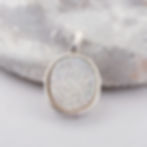Bring a piece of ancient history into your home with this stunning Crinoid Stem Fossil. This unique and mesmerizing fossil is a remnant of an ancient marine creature that lived over 400 million years ago during the Paleozoic era. Each fossil is beautifully preserved, with delicate and intricate details that display the natural beauty of the prehistoric world. In metaphysical beliefs, Crinoid fossils are said to carry the energy of balance and harmony, making them the perfect addition to any crystal or fossil collection. Display this remarkable piece in your home or office to invite in the grounding and calming energy of the Earth's distant past.
*Stone will be randomly selected for you.
*Stone may vary slightly in size, shape and color other than the one pictured
Crinoid Stem Fossil
Crinoid stem fossils, remnants of ancient sea creatures that thrived in the Paleozoic Era, offer a fascinating glimpse into the Earth's primordial marine ecosystems. Crinoids, often referred to as sea lilies or feather stars, belonged to the Echinodermata phylum, sharing lineage with modern-day sea urchins and starfish. These marine invertebrates possessed long, slender stems composed of stacked calcite segments, which anchored them to the seafloor, while their feathery arms extended upwards to capture food particles from the water. The fossilized stems, dating back hundreds of millions of years, exhibit a distinctive pattern of circular or pentagonal plates, a testament to their unique skeletal structure. Discovered globally, crinoid stem fossils not only provide crucial insights into ancient marine biodiversity but also serve as indicators of the geological age and environmental conditions of their sedimentary rock strata, making them invaluable to paleontologists and geologists alike.
Crinoid stem fossils, which are the petrified remains of ancient marine organisms, are not toxic. These fossils are composed primarily of calcite, a mineral form of calcium carbonate, which is neither harmful nor toxic to humans. In fact, calcite is a common substance found in nature, contributing to the makeup of limestone and marble, and is even present in items ranging from construction materials to dietary calcium supplements. Handling or owning crinoid stem fossils poses no health risk, making them popular among collectors and educators for study and display purposes. Their scientific significance and aesthetic appeal, combined with their non-toxic nature, ensure that crinoid stem fossils remain a safe and fascinating subject of interest for fossil enthusiasts and researchers alike.
















